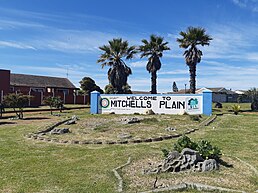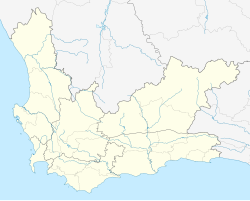
Back Mitchells Plain Afrikaans Mitchells Plain German Mitchells Plain French Mitchells Plain NSO Mitchells Plain Xhosa Mitchells Plain Zulu
Mitchells Plain | |
|---|---|
From top, Mitchells Plain sign at the intersection of the M7 and R300. An aerial view of Mitchells Plain (centre right). A view over Westridge from the dunes at the Westridge Gardens (centre left). The notable Luco Meyer town centre taxi rank (bottom left). Mitchells Plain town centre market (bottom right). | |
| Coordinates: 34°3′2″S 18°37′5″E / 34.05056°S 18.61806°E | |
| Country | South Africa |
| Province | Western Cape |
| Municipality | City of Cape Town |
| Area | |
• Total | 43.76 km2 (16.90 sq mi) |
| Population (2011)[1] | |
• Total | 310,485 |
| • Density | 7,100/km2 (18,000/sq mi) |
| Racial makeup (2011) | |
| • Black African | 7.3% |
| • Coloured | 90.8% |
| • Indian/Asian | 0.6% |
| • White | 0.2% |
| • Other | 1.1% |
| First languages (2011) | |
| • English | 47.4% |
| • Afrikaans | 46.9% |
| • Xhosa | 3.3% |
| • Other | 2.4% |
| Time zone | UTC+2 (SAST) |
| Postal code (street) | 7785 |
| PO box | 7789 |


Mitchells Plain is a large census designated sub-place[2] located within the City of Cape Town, Western Cape, South Africa and situated about 28 km (17 mi) from the Cape Town city centre. It is one of South Africa's largest residential areas and contains multiple smaller suburbs. It is located on the Cape Flats on the False Bay coast between Muizenberg and Khayelitsha. Conceived of as a "model suburb" by the apartheid government, it was built during the 1970s to provide housing for Coloured victims of forced removal due to the implementation of the Group Areas Act.
At an estimated population of 290,000–305,000[3] people, it comprises a number of sub-sections which reflect the diverse class backgrounds of the population. It was once a major stronghold of the United Democratic Front, the broad-based ANC-sponsored anti-apartheid body. It also has one of greater Cape Town's biggest shopping centres, known as the Liberty Promenade.
- ^ a b c d "Main Place Mitchells Plain". Census 2011.
- ^ "City of Cape Town – 2011 Census Suburb Mitchells Plain" (PDF). City of Cape Town. July 2013. Retrieved 22 December 2021.
- ^ "Archived copy" (PDF). Archived from the original (PDF) on 2011-05-15. Retrieved 2013-03-11.
{{cite web}}: CS1 maint: archived copy as title (link)







